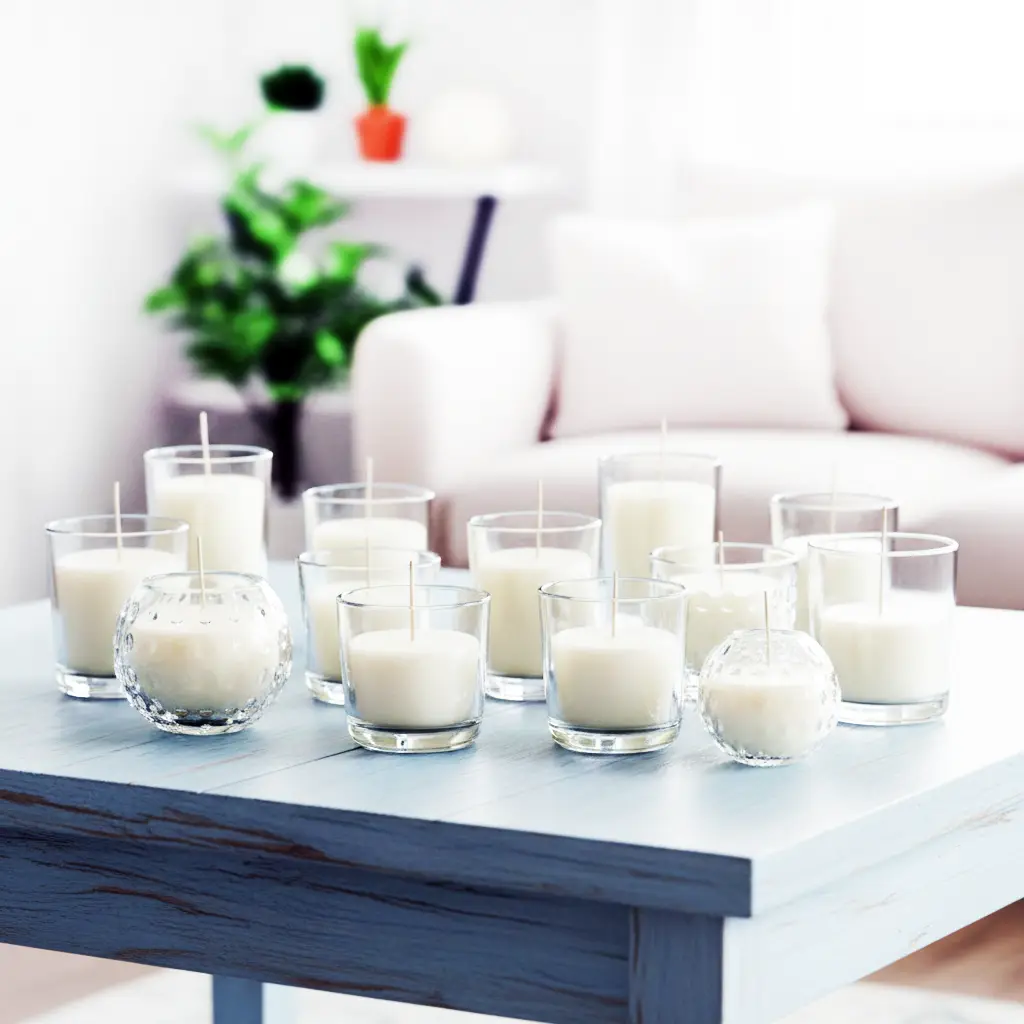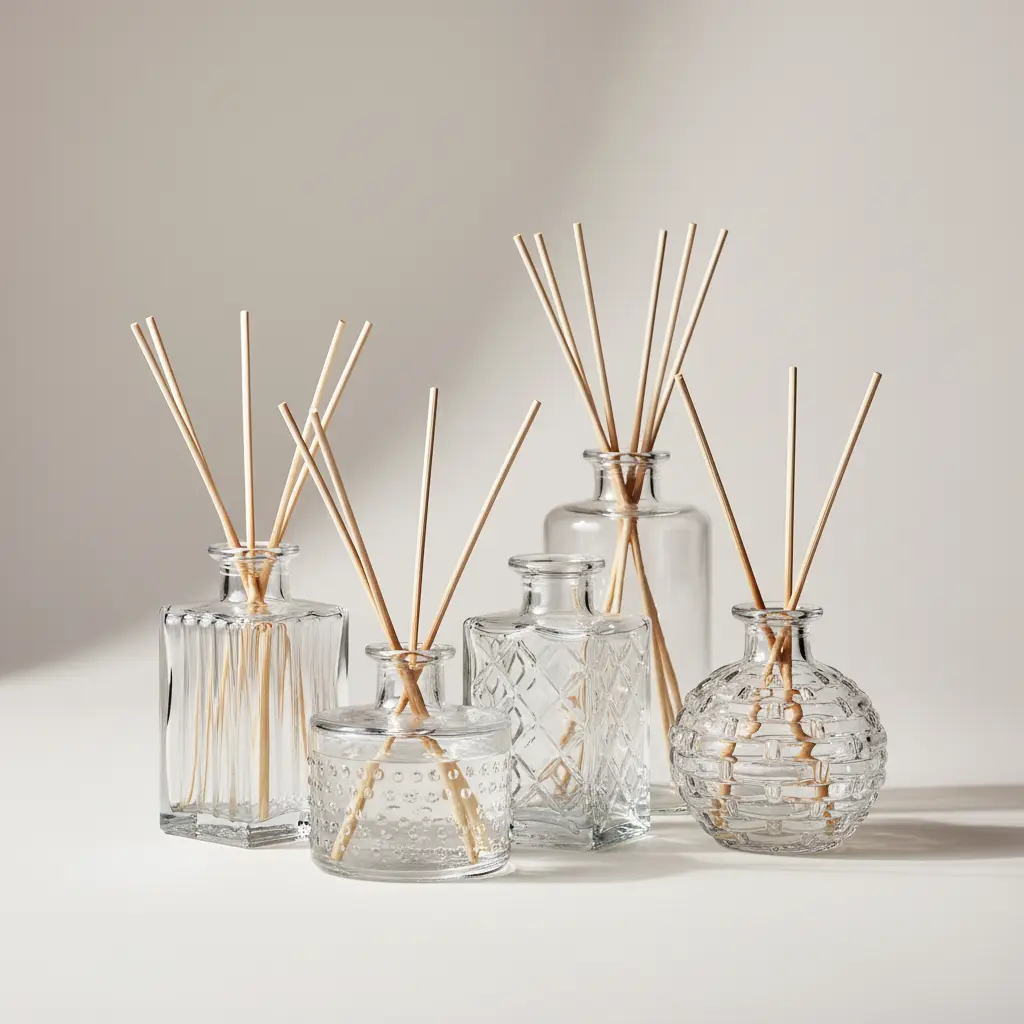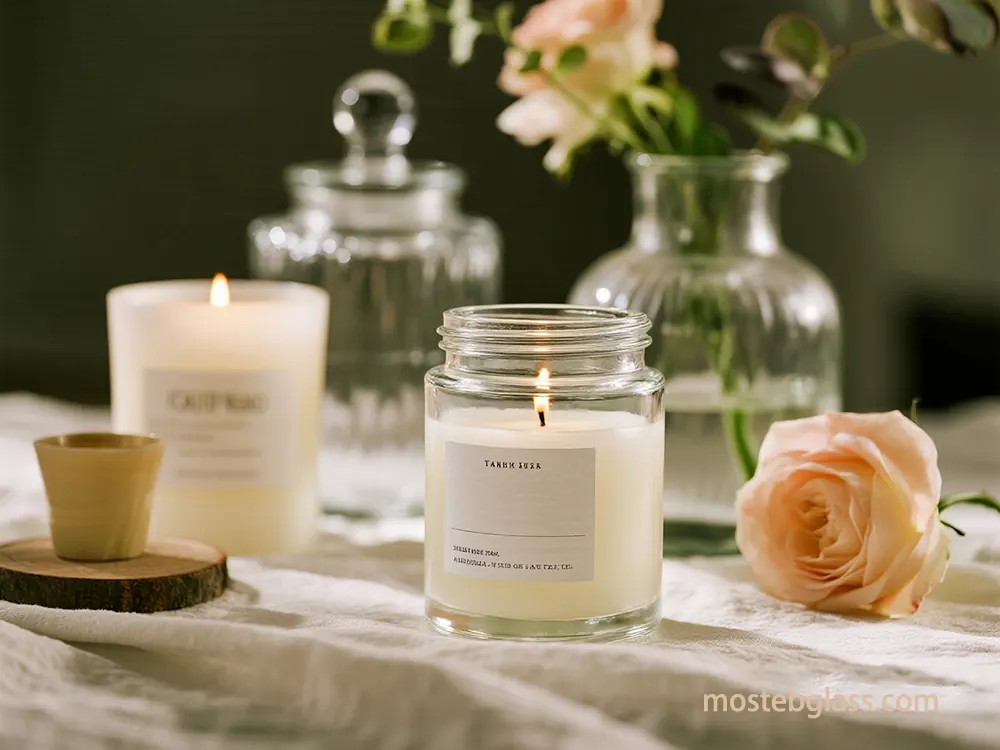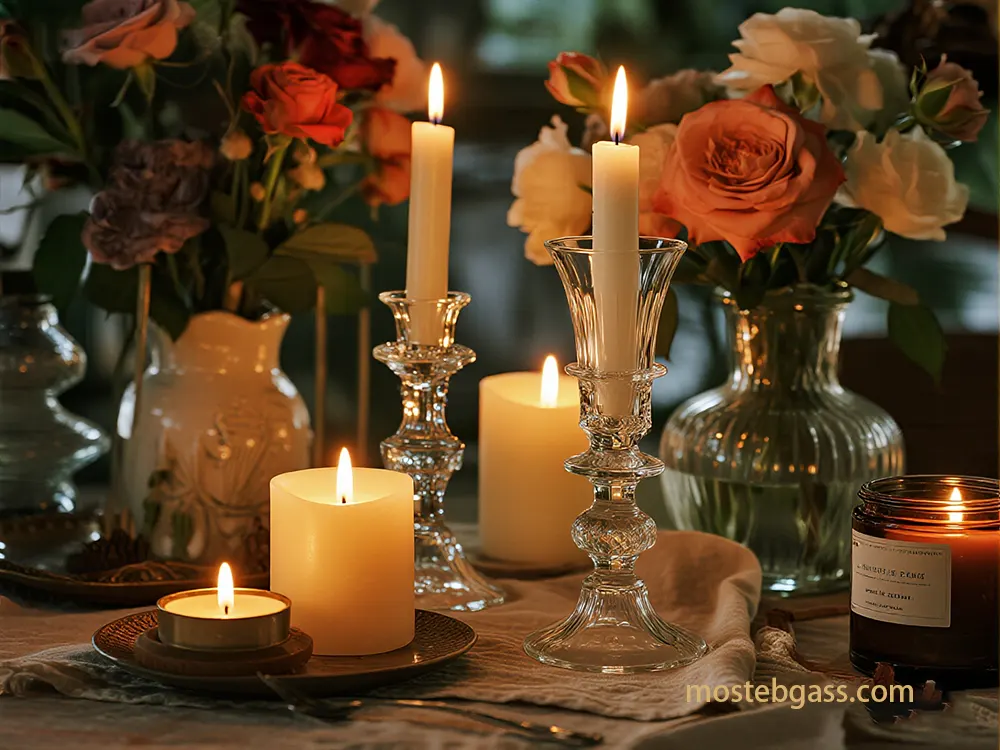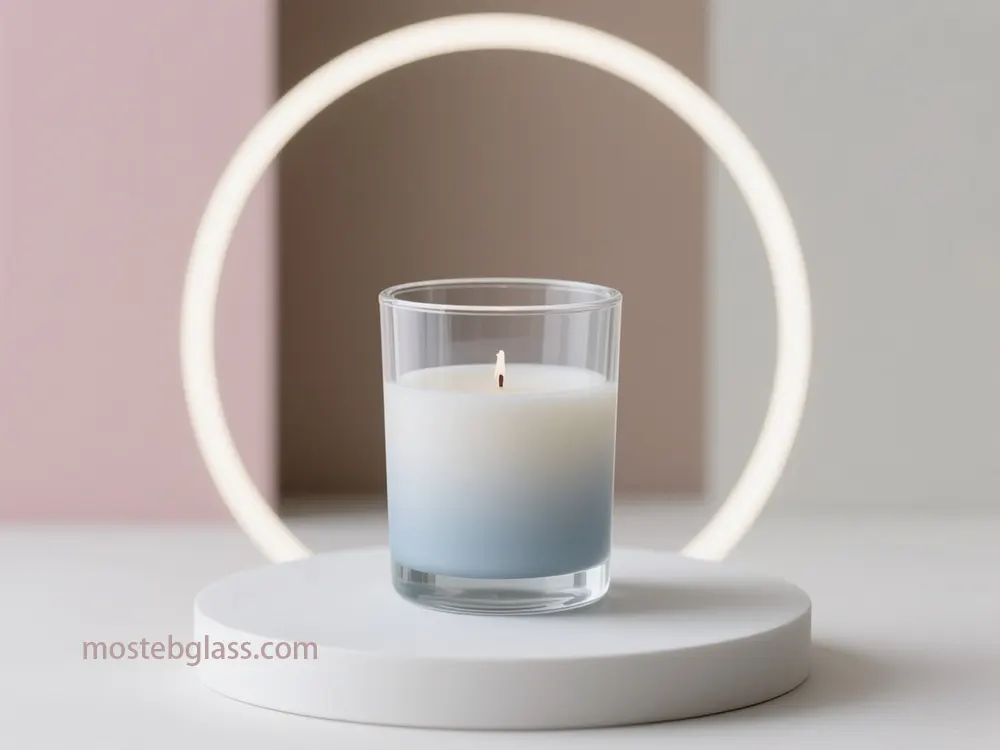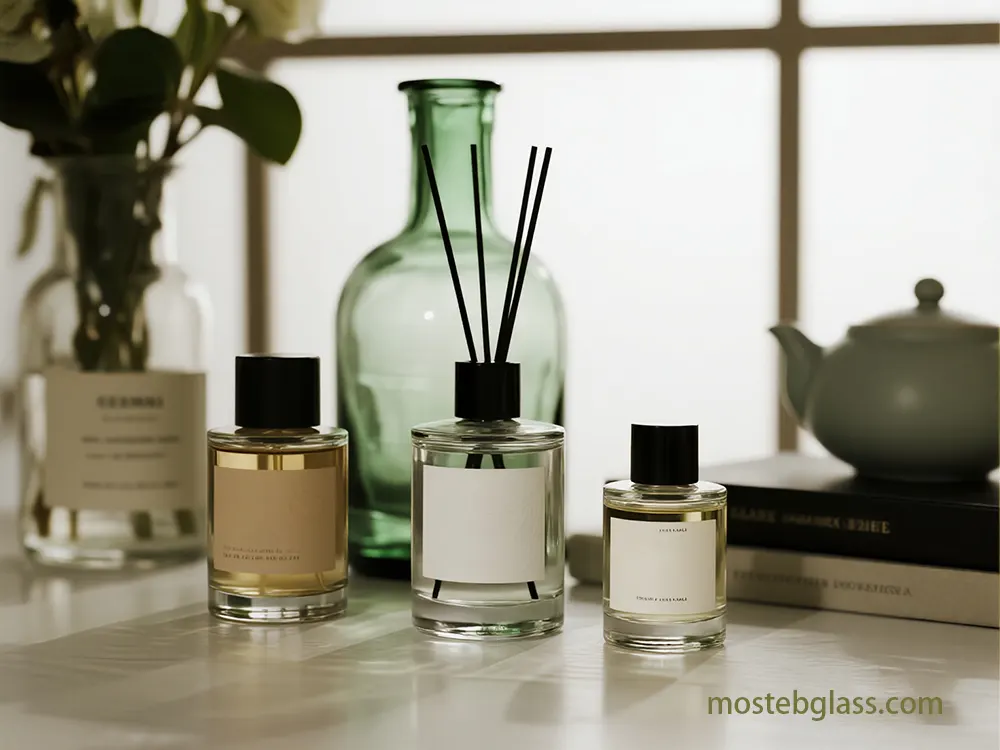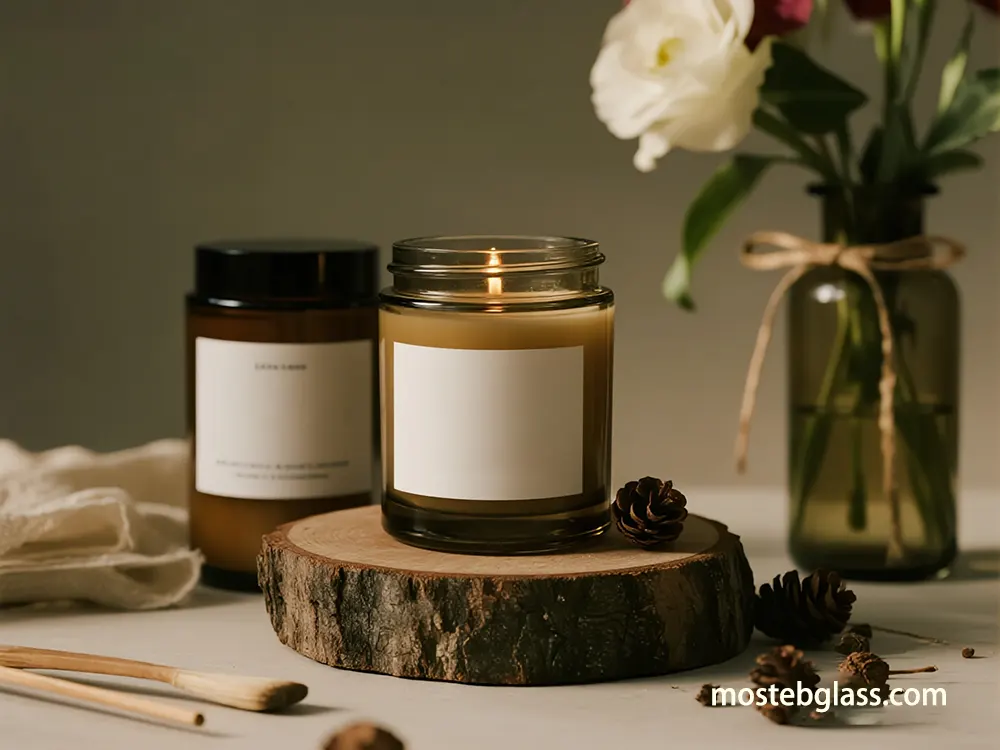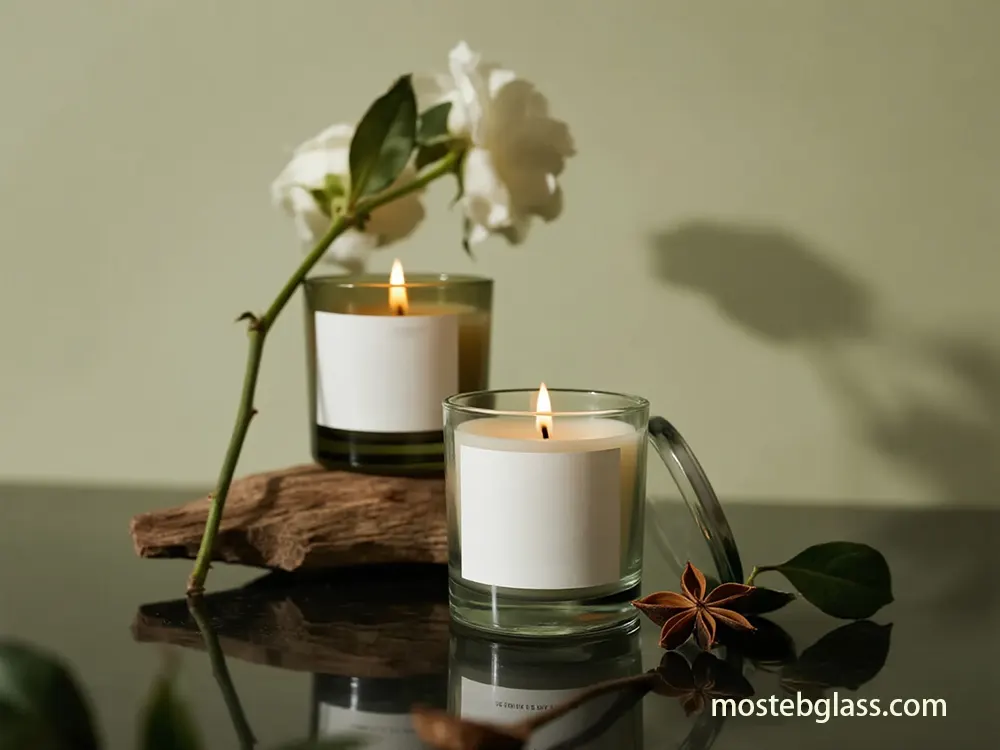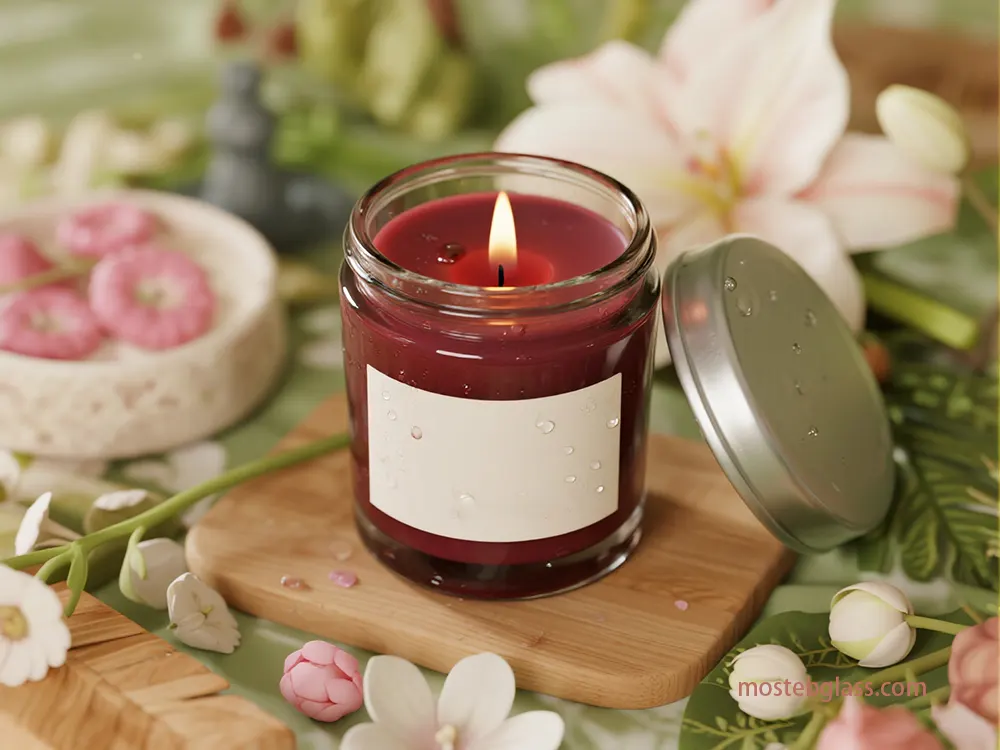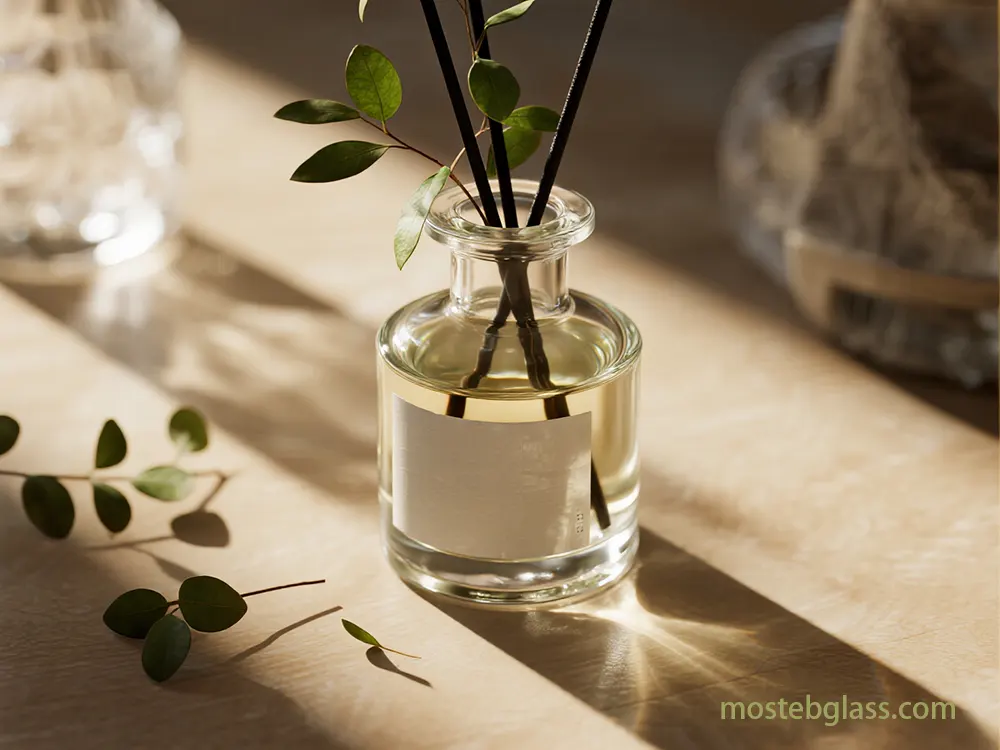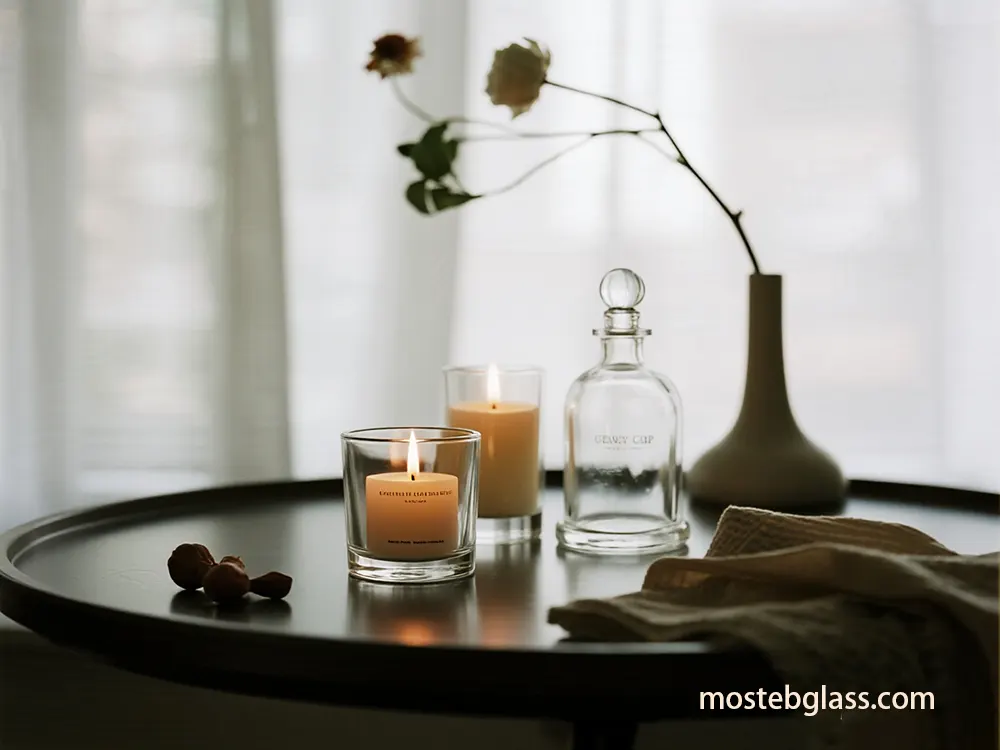Good heat management is very important for a burn that is continuous and uniform. For instance, the thicker glass will keep the heat for a longer period of time, which not only can influence fragrance volatilization in a positive way but also create more consistent burning environment.It should be noted that glass is a good thermal conductor, and without proper managing, it may cause uneven or faster candle burning.
Alumina Content: One of the most important factors determining the thermal properties of glass is the content of alumina (Al₂O₃) in the glass structure. In the case of magnesium aluminum silicate (MAS) glass, doubling alumina content from 7.6 to 14.7 mol% not only reduces the average coefficient of thermal expansion but also raises the glass transition temperature, thereby increasing both the structural rigidity and the thermal stability. Al₂O₃ serves as a network-former, thus by raising the melting temperature, increasing the tensile strength and decreasing the thermal expansion simultaneously.
Due to a very low coefficient of thermal expansion (approximately
3×10−6 K−1 Mosteb K
−1
at 20°C) borosilicate glass, in fact, is highly resistant to thermal shock, which basically means that it can handle temperature differentials of around 166°C (330°F) without cracking and can be rapidly heated or cooled up to 850°C 6466. Because of these properties, it is considered a mainstream material for burning a candle in a safe and consistent way.
Soda-Lime Glass:
Regular soda-lime glass can be attractive in terms of price, but it is characterized by a large coefficient of thermal expansion (
°C
) and it is also very weak when it comes to thermal shock resistance, thus it is more likely to be cracked if there is a sudden change in temperature. Its usage in candle production is mainly regarded as hazardous unless it is specifically annealed and tested condition.
Multi-Layered Glass Structures:
Layered
that contain two glass layers and are most probably manufactured from borosilicate glass, are intended for being resistant against high-temperature-conditions.The method provides an opportunity to reduce thickness of walls and at the same time maintain strength of the structure, thus more precise heat transfer can be performed.
3.2. Design Elements for Improved Scent Throw
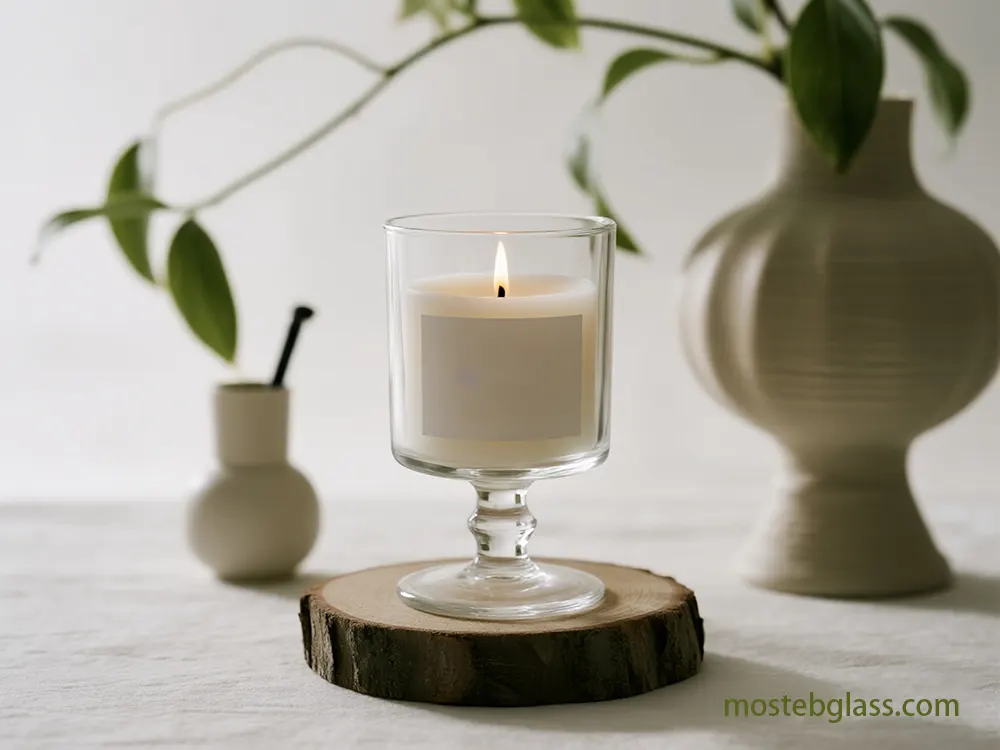
Scent throw is basically the release of a fragrance and container design determines almost entirely the extent to which this takes place.
Container Diameter:
The use of wider candle containers allows the creation of larger melt pools which are the main factor in attaining stronger hot scent throw.In addition, a wide-mouth bottle also serves fragrance molecules by providing more areas for them to attach and thus diffuse.
Surface Texture:
- On embossed candle jars, the tiny ridges and unevenness of which, can, in theory, result in the increase of the surface area that comes into contact with the wax’s aromatic oils and hence more scent molecules are released without the user’s conscious participation. From personal experiments, one can deduce that as much as 15% more scent can be dispersed in a room because of using embossed jars compared to the plain ones.Nevertheless, if the embossing is very deep or the glass is thick, then at the same time, these factors may contribute to the occurrence of uneven burning as the heat may be trapped in the local areas. 3.3. Precision Lid Fit for Preservation
- The trend of packaging includes vibrant colors (deep blues, fierce red, rich emerald) and custom shapes. Airtight Seals: Lids need to offer an airtight sealing in order to prevent the liquid evaporation of scented oils and also to protect the candle from dirt and impure air. For this purpose precision manufacturing techniques like injection molding for complex geometries and integrated seals are required.3Glass decor is a strategic property for retail brands that demand discrimination and deep consumer connections. Its versatility, beauty appeal, and technical integration make it indispensable to tell modern brand story. Taking advantage of innovative glass solutions, retail sellers can create an immersive, dynamic and memorable shopping experiences running business success.10Silicone gasket and O-rings are very good because they have excellent temperature resistance, and acid resistance and are also flexible. But to prevent the specific polymer blends like chemically resistant elastomers from being degraded by concentrated fragrance oils, it is very important to use the right ones. Child-Resistant (CR) Lids:For some product types or markets, child-resistant packaging can be an essential safety feature. The mechanisms of such lids include “push-and-turn” or “squeeze-and-turn” operates, designed in accordance with standards like ASTM D3475. Being able to combine these without compromising the look or greatly increasing the price is the main challenge. 3.4. Base Stability and Reusability Considerations
- By putting a big, heavy base on a jar of a candle, its stability is ensured and the heat is able to spread away from the surface the candle rests on, especially the area where the flame is going. Besides, the aspects of reusing are becoming more and more important that way they influence the designer in his decision of creating a product that is easy to clean and durable.3.5. Speculative Thermal Management Elements8.3Glass decor is a strategic property for retail brands that demand discrimination and deep consumer connections. Its versatility, beauty appeal, and technical integration make it indispensable to tell modern brand story. Taking advantage of innovative glass solutions, retail sellers can create an immersive, dynamic and memorable shopping experiences running business success.10Silicone gasket and O-rings are very good because they have excellent temperature resistance, and acid resistance and are also flexible. But to prevent the specific polymer blends like chemically resistant elastomers from being degraded by concentrated fragrance oils, it is very important to use the right ones. Phase-Change Materials (PCMs):For some product types or markets, child-resistant packaging can be an essential safety feature. The mechanisms of such lids include “push-and-turn” or “squeeze-and-turn” operates, designed in accordance with standards like ASTM D3475. Being able to combine these without compromising the look or greatly increasing the price is the main challenge.4. The Science of Strength and Performance: Manufacturing Processes and Material Innovations
- Mosteb’s glass candle jars undergo a variety of sophisticated manufacturing processes and Mosteb incorporates modern fabrication methods and material science breakthroughs to deliver the required glass candle jars’ safety and functional Mosteb utilizes high-tech manufacturing techniques and advanced Mosteb employs state-of-the-art production methods and cutting-edge material science innovations to meet the safety and functional requirements of its glass candle jars. 4.1. How a Glass Candle Jar Manufacturer Strengthens Durability Through Advanced Processes For investment casting, tooling design/manufacturing usually takes -6 4-6 weeks, followed by -4 2-4 weeks for sample casting; The complex parts extend the timeline. Rapid prototyping prototyping by 3D printing can reduce the lead times $ 30 minutes to $ 7 $ 7. New Mass Production Lines in new machinery, equipment or facilities can take $ 2-6 a month. Glass melting is crucial for expansion of capacity, with key items, including furnace, cutting and shaping machines. Tempering:
Chemical Tempering:
Basically, the glass is immersed in a molten potassium salt bath, and the surface reactions that occur cause larger potassium ions to replace lower sodium ions in the glass surface. This thereby establishes a high compressive stress layer (up to 600 N/mm² for standard glass) making the glass 15 to 20 times stronger than normal float glass by Chemical tempering is a method of strengthening thin glass (below 3-4mm) and complex shapes while still keeping the glass with very good optical properties and no distortions, ion exchange is usually done this way.
- Thermal Tempering:By reeving glass to extremely high temperature (similarly, 600-700°C) and chilling it quickly, thermal tempering sets the compressive and tensile stresses on the surface and further in the volume of the material. This consequently increases the glass’s ability to resist a sharp blow given (especially for glass over 6mm thick) and also increases its thermal shock resistance (it can now withstand temperature changes of more than 150°C or up to 200°C).It additionally causes the glass to fragment into small, granular, less injurious pieces, thus it can be classified as a type of safety glass.
- Trade-offs: As a rule, the cost of production for chemically tempered glass is higher, and its efficiency is lower due to the longer cycle time (e.g., 8 to 16 hours). Thermal tempering has a lower price and a larger production capacity, which makes it more cost-effective for high-volume applications.
4.2. Material Innovations: Specialized Glass Compositions and Protective Surface Coatings
Specialized Glass Compositions:
- With reference to Section 3.1, the most important advantage of borosilicate glass over other types of glass is its resistance to thermal shock owing to a very low thermal expansion coefficient.The addition of alumina also improves thermal stability and resistance to thermal shock. Protective Surface Coatings:
- Sol-Gel Coatings: These hybrids of ceramics are mostly made by silicon dioxide (SiO2) and produce a very hard, compact, glassy-like surface. They strengthen the glass by the assimilation of existing defects and the bridging of cracks since the flexural strength was reported to be raised from 47 MPa to 98 MPa. Besides, they grant the glass surface with resistance to scratching, the capability of self-cleaning, and also high heat resistance (up to 455°C/850°F).
- Ceramic Coatings: Nanotechnology-based products containing SiO2 interact with the glass surface to manufacture an ultrahard, durable, semi-permanent protective layer, which is the ultimate in protection against wear and tear. These coatings’ lifespan is about 2-5 years, and they provide greater scratch resistance, stronger hydrophobic effects, and the heat absorption may be lowered as well. One of the uses of Cerakote Ceramic Glass Coat Protectant is 9H Pencil hardness and high heat resistance (450°C).
Polymer Coatings:
The soft polymer coatings (e.g., polysiloxane polymeric water emulsion, liquid PVC) that are applied on the outer surface of the glass containers contribute to the overall strength, in particular, the scratch resistance is improved, and most importantly, in the case of glass breakage, the shattered glass and the liquid will be kept inside.The ONECOAT system, which is based on polysiloxane chemistry, is waterborne and glass recycling friendly as it breaks down to SiO2.
4.3. Advanced Quality Control: AI-Driven Optical Inspection
- Mosteb uses state-of-the-art AI-powered optical inspection systems that are very effective. In short, these systems use a deep learning model like Convolutional Neural Networks (CNNs) to identify and classify a large variety of tiny glass defects that might be under the surface of the glass are also possible. These include inclusions, striae, micro-cracks, stress points, and changes in wall thickness.Enhanced Accuracy and Speed:
- AI-driven Automated Optical Inspection (AOI) systems can reach accuracy levels of up to 99.86% compared to manual visual inspection, which is only 80-85%, thus drastically reducing false positive and negative cases. Moreover, they permit high-speed, real-time processing, which is usually carried out by edge computing, and this results in immediate feedback and quick decision-making on the production line. Seamless Integration and Predictive Maintenance:
Such systems can be easily incorporated in the present manufacturing lines where they provide real-time data for the immediate adjustment of the process, which is essential for ‘zero-defect’ production. By the same token, quality control becomes predictive maintenance by AI through the analysis of sensor data to recognize patterns that signify the imminent failure of the equipment, thus lessening the unplanned downtimes.
Advanced Imaging and Robotic Integration:
AI augmented by multispectral imaging and hyperspectral imaging (HSI) in the Near-Infrared (NIR) can not only detect the subsurface of the materials for defects but can also determine the film thickness and other properties with extremely accurate precision. Besides, the latest technology integration systems can even do it themselves by starting the removal or correction process via connected robots without human intervention for the most common problems.
- Story through props and themes:The specialized lighting setups (LED, backlighting, and ring lights) together with commercial-grade cameras of extremely high resolution have been purposely designed to solve the problems arising from the inspection of transparent and highly reflective glass surfaces and, as a result, allow for reliable defect detection in a wide range of glasses.
- 5. Navigating the Landscape: Regulatory Standards and Market-Driven Demands
- The worldwide regulatory framework for the safety of candle containers is quite complicated and requires a very careful approach to compliance. Mosteb works through these different requirements to ensure both access to the market and consumer trust. 5.1. Influence of Specific Regulatory Standards
- US Standards (ASTM & CPSC): ASTM F2179 (updated 2020) is a standard that defines requirements for the glass used in candle containers and sets performance criteria by which the products should be tested (annealing, thermal shock resistance, and scratch testing). In order to meet requirements, every batch of glass used in production has to go through a tightly controlled process, and there should be no failures. When determining compliance with the thermal shock resistance test, a temperature differential of 50 °C is usually employed.The U.S. Consumer Product Safety Commission (CPSC) also contributes to product safety through the setting of standard requirements.
- California Proposition 65: This regulation requires warnings on products that emit over 900 different chemicals that have been known to cause cancer, birth defects, or reproductive harm. The manufacturers have to eliminate the substances like phthalates, benzene, lead, and toluene from candles that are sold to the Californian market.
EU Regulatory Framework (GPSD, GPSR, EN Standards):
- An integrated multi-level structure is utilized by the EU with the General Product Safety Directive (GPSD) 2001/95/EC and General Product Safety Regulations (GPSR) supplementing the Directive and other laws in the area of product safety. The core standards here are EN 15493:2019 for fire safety (stability, flame height, self-extinguishing, re-ignition),and EN 15494:2019 for product safety labels, which offers in-depth guidance on the design and content, also providing alternatives for limited label space. The EU REACH and CLP are also imposing stringent restrictions on the quantities of chemical substances permissible, in addition to requiring that these substances be labeled appropriately when they are hazardous.Canadian Regulations (SOR, ASTM):
- Canada’s SOR/2016-165 (Candle Regulations), is a regulatory document for the candle industry, which often refers to the technical standards published by ASTM such as ASTM F2417-17 for fire safety and ASTM F2058-07(2021) for labeling.A very significant provision is that bilingual safety warnings and instructions must be provided both in English and in French, and the minimum size of the warning font should not be less than 1.5 mm.
- Australian Consumer Law (ACL): Australia does not have any specific standards related to the manufacturing of candles, but it depends on the general Australian Consumer Law (ACL) and Trade Practices Act, which are enforced by the ACCC. The ACCC has issued a permanent ban on the use of combustible candle holders and wicks that contain more than 0.06% of lead. The provision for warning labels is part of the legal framework although the format is less prescriptive.
- Japanese Regulations (PLA, CPSA): Japan is very particular about deciding the components that go into the product, therefore it requires the listing of the raw material components as well as the burning temperature for perfumed candles. PSE certification is mandatory for electronic candle safety concerns. Japan’s Product Liability Act (PLA) is very strict and holds manufacturers directly responsible for any damages that may result from defects in their products, while the Consumer Products Safety Act (CPSA) requires that “Serious Product Accidents” be reported.
- 5.2. Market-Driven Demands and Unique Requirements Different market segments impose unique safety and functional requirements:
Luxury Market:
Besides requiring excellent looks, high-quality materials (e.g., borosilicate glass), and usually the unique designs, luxury market also demands rigorous safety testing to maintain the reputation of the brand.
- Mass-Market: Focuses on price and volume of production which implies the need for the efficient production processes (e.g., thermal tempering) with the safety standards being at the minimum level.
- Outdoor Use: Requires increased abilities of withstanding the wind, holding the balance, and possibly more strong glass compositions or coating in order to resist the outdoor elements.
- Sustainability-Focused Consumers:Are the main reasons for the recycled content, recycling-friendly designs, and clear solutions for the product life cycle transparency.
- 5.3. The "Container as Part of the Candle System" ApproachRegulations frequently consider the container to be a component of the candle’s safety performance. As a result, the container’s material, its condition, stability, and resistance to heat have to be tested together with the specific wax and wick combination. If wick size, fragrance load or container dimensions are changed, it is necessary to go through testing again.
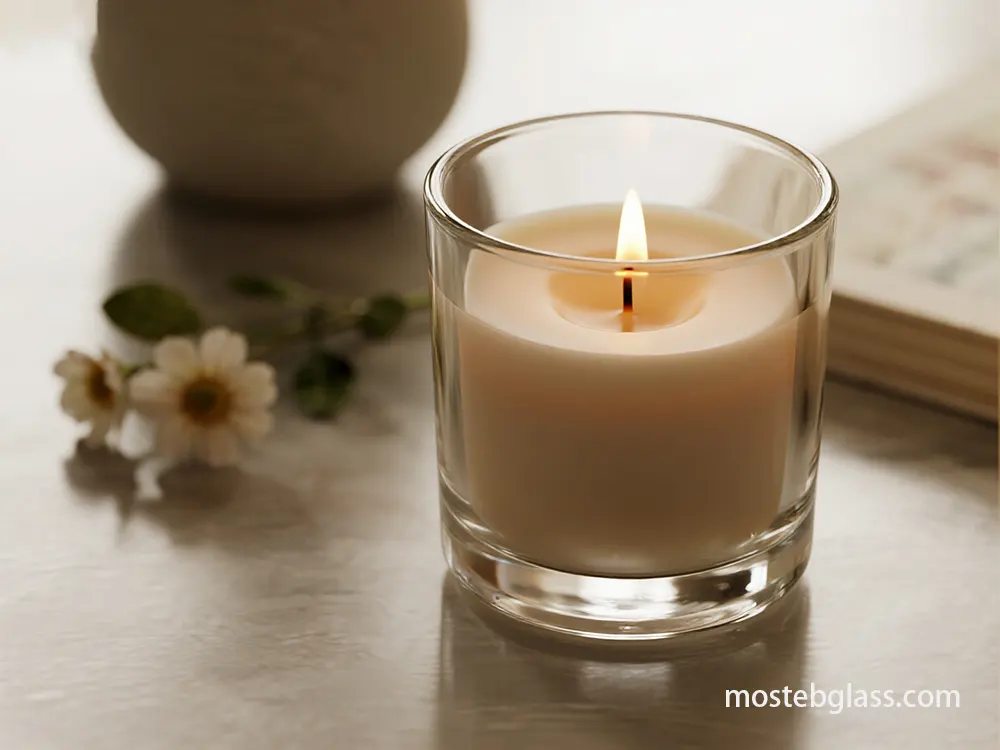
6. Future Horizons and Sustainable Cycles: Emerging Technologies and End-of-Life Considerations
Mosteb is actively involved in the search for future trends and sustainable solutions, which covers not only the innovative glass technologies but also the comprehensive end-of-life solutions for its glass candle jars.
6.1. Challenges in Current Recycling and Reuse
- Incompatibility of Specialized Glass: As a rule, glass candle jars are made of tempered or borosilicate glass, both of which have higher melting points and as such, are not compatible with the standard glass recycling streams. This results in contamination and the glass ending up in landfills.
- Contamination from Residue: Residual wax, wicks (in particular, metal ones), fragrance oils, and the likes of metalized finish, glitter, and decals are some of the most difficult contaminants that not only interfere with recycling but also lower the quality of the cullet.
- 6.2. Advanced Sorting, Cleaning, and Remanufacturing Processes Industrial Sterilization for Reuse:
- When talking about direct reuse, sterilization on an industrial scale is a must. Among the methods are soaking in boiling water, use of dishwashers with the “sanitize” feature, oven methods (120 °C for 10-15 minutes), and hot-fill techniques.To perform these, residue-free thorough pre-cleaning is obligatory.Novel “As-Is” Glass Up-Casting:
- This innovative technique allows the casting of volumetric glass parts straight from “as-received” glass waste and at lower temperatures (750–1200°C). It is very adaptable since it can handle a broad range of glass compositions and can also tolerate more contamination while requiring less purification. High-Purity Cullet Production:
- Purly recycling from jar-to-jar and thus being truly closed-loop, is only possible if the cullet is of very high purity. The “Close the Glass Loop” initiative is reaching 90% collection rates and high recycling efficiency, thus it is possible to significantly reduce virgin material, energy consumption, and CO2 emissions. 6.3. Successful Case Studies and Programs
Many candle brands have introduced consumer take-back and refill programs, offering the incentive of discounts or credits for returns. Some of the brands are Mill Pond Candles, Get Lit Candle Co., Noël & Co., CandleXchange, Slow Made, and The Candle Lab. Besides that, big brands and consortia are also working on reusable packaging systems like Loop in collaboration with Unilever, which is a way to show the shift towards deposit-return models.
6.4. Emerging Self-Healing Glass Technologies
- Self-healing glass is a significant technological breakthrough that can dramatically extend product life and improve safety. Diverse Mechanisms:
- Among the research for self-healing glass are polymer-based systems, bio-inspired peptide structures, and special chalcogenide glasses. Peptide Glass:
- A new glass, which can repair itself when water is applied and is formed by a short aromatic tripeptide (YYY), was found in 2024. Besides that, it has very good heat and chemical resistance. Polymer Glass:
- A polymer glass made of polyether thiourea (TUEG3) that can be mended by simply pressing the broken sides together at room temperature (21°C) was found in 2017. The process takes just a few hours, and the original strength of the glass is restored. Chalcogenide Glass:
At research conducted in 2024, it was found that chalcogenide glass could close tiny fissures in the material by itself after being exposed to gamma radiation, in which the bonds loosen and reform at room temperature.
Thermal and Mechanical Stress Resilience:
The self-healing materials’ design allows for the repair of damage at the micron level and thus prevents the extension of damage. The peptide and polymer glasses are an example of the ability to heal in normal conditions and be strong against mechanical stress. Additionally, research on self-healing thermal barrier coatings also indicates that it can greatly extend the lifetime of the unit under thermal cycling, which is very important for candle containers.
Environmental and Economic Benefits:
Self-healing glass, through product life extension, is able to reduce the frequency of replacements and consequently the demand for production, thus saving resources and leaving a minimal environmental footprint.
- Expensive production, complicated manufacturing processes, and the requirement of specialized facilities (e.g., glove boxes for chalcogenide glass) are still major obstacles for the introduction of these products on the market. Applicability to Candle Containers (Speculative):
- The feature of the self-healing glass, which enables it to mend micro-cracks brought about by repeated thermal cycling, can not only increase the lifespan of candle jars but also make them safer. In addition, this is in line with sustainability goals as fewer wastes and less new glass production are generated. 6.5. Role of Digital Technologies (Blockchain)
One of the most useful tools blockchain technology has to offer is the creation of easily accessible and long-lasting records for materials, which is a big step towards the circular economy model.
- Material Traceability: With blockchain, every step of the life cycle of a product is traceable, starting with the extraction of raw materials, going through processing, manufacturing, distribution, consumption, and finally waste management. This allows for the confirmation of eco-friendly activities as well as the tracking of environmental footprints.
- Consumer Empowerment: The usage of blockchain platforms can allow customers to have access to information regarding the roots and environmental effects of a product, mostly by scanning QR codes. This will lead to more conscious purchasing choices and will also motivate consumers to become active players in circular loops through rewards.
- Supply Chain Resilience:The technology can also make supply chains more robust by giving the businesses a shared, secure, and unalterable ledger. This coupled with the complete visibility of virgin vs. recycled materials allows the companies to strategize and take effective steps towards recovery in a collaborative way.
7. Conclusion: The Integrated Approach to Superior Candle Jar Design
High-performance glass candle jars, especially for a top glass candle jar manufacturer like Mosteb, require a carefully planned integrated approach that balances safety, functionality, manufacturing excellence, and innovation. It means choosing advanced glass compositions like borosilicate for better thermal shock resistance and using AI-driven optical inspection for micron-level defect detection at every point of the product lifecycle.
The emphasis on safety can be seen through the strict following of global regulatory standards, chemical management that is always a step ahead, and the design of “reasonably foreseeable misuse.” Functionality is improved by effective heat management, design features that enhance scent throw, and precision-engineered lids that ensure product integrity. Mosteb is already considering futuristic ideas like self-healing glass to shorten the product lifespan, among other advanced closed-loop recycling methods such as “glass up-casting” and blockchain for traceability, to enable a completely circular economy. This comprehensive plan is making sure that Mosteb’s glass candle jars are not only complying with the requirements of the consumers and industry but also going beyond them, thus providing a safe, sustainable, and superior candle experience.
Wholesale Diffuser Bottles
- Wholesale Glass Vases Latest Insights
- Comment Submit your opinion
- get a free quote Complete our quote request form or email us at
- to receive a customized quote from our product specialists. Select a product
- glass candle jars Reed Diffuser Bottle
- Quantity contact our Product Expert
- Zorluklar: to protect your information.
- Your primary email address Company name
Number
MOQ 1000
- Please provide us with the capacity, shape, color, and quantity of the glass containers you require. Alsoplease feel free to share any other details or specific requirements to help us better understand yourproject. full name
- email adressTell us your requirements, such as capacity, quantity, customization, etc.
- breadcrumbs The technology can also make supply chains more robust by giving the businesses a shared, secure, and unalterable ledger. This coupled with the complete visibility of virgin vs. recycled materials allows the companies to strategize and take effective steps towards recovery in a collaborative way.
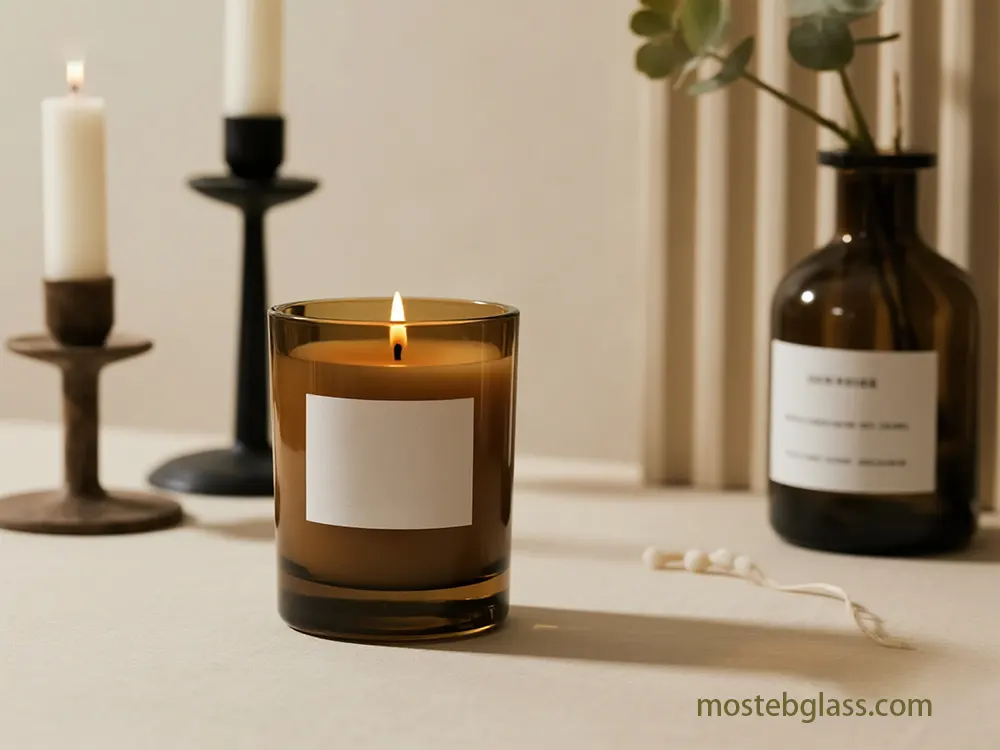
7. Conclusion: The Integrated Approach to Superior Candle Jar Design
High-performance glass candle jars, especially for a top glass candle jar manufacturer like Mosteb, require a carefully planned integrated approach that balances safety, functionality, manufacturing excellence, and innovation. It means choosing advanced glass compositions like borosilicate for better thermal shock resistance and using AI-driven optical inspection for micron-level defect detection at every point of the product lifecycle.
The emphasis on safety can be seen through the strict following of global regulatory standards, chemical management that is always a step ahead, and the design of “reasonably foreseeable misuse.” Functionality is improved by effective heat management, design features that enhance scent throw, and precision-engineered lids that ensure product integrity. Mosteb is already considering futuristic ideas like self-healing glass to shorten the product lifespan, among other advanced closed-loop recycling methods such as “glass up-casting” and blockchain for traceability, to enable a completely circular economy. This comprehensive plan is making sure that Mosteb’s glass candle jars are not only complying with the requirements of the consumers and industry but also going beyond them, thus providing a safe, sustainable, and superior candle experience.
